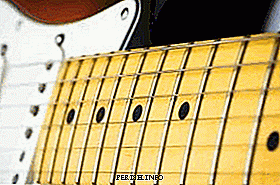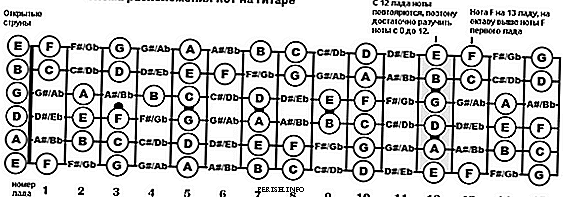 Many novice guitarists in the selection of compositions are faced with some tasks, one of which is how to identify any notes on the guitar neck. In fact, this task is not so difficult. Knowing the location of the notes on the neck of the guitar, you can easily pick up any piece of music. The device of the guitar is far from the most difficult, but the notes on the fingerboard are slightly different than, for example, keyboard instruments.
Many novice guitarists in the selection of compositions are faced with some tasks, one of which is how to identify any notes on the guitar neck. In fact, this task is not so difficult. Knowing the location of the notes on the neck of the guitar, you can easily pick up any piece of music. The device of the guitar is far from the most difficult, but the notes on the fingerboard are slightly different than, for example, keyboard instruments.
Build guitars
First you need to remember the structure of the guitar. Starting from the first string (thin) and ending at the sixth (thickest), the standard order will be as follows:
- E - note "mi" is extracted on the first open (not clamped on any fret) string.
- H - on the second open string the note "si" is extracted.
- G - reproduces the note "salt" is not clamped third string.
- D - the note "re" is extracted on the open fourth string.
- A - string number five, not clamped - note "la".
- E - on the sixth open string, the note "ee" is extracted.
This is the standard guitar pitch used when tuning the instrument. All notes are played on open strings. Having memorized the standard system of the guitar, finding any notes on the guitar neck will not cause any problems at all.
Chromatic scale
Next, you need to refer to the chromatic scale, for example, the scale of "C major" below will greatly facilitate the search for notes on the guitar fretboard:
It follows that each note, clamped on a certain fret, sounds higher by a half tone, than clamped on the previous fret. For example:
- The second non-clamped string, as we already know, is the note "si", therefore, the same string will sound higher by a half-tone of the previous note, that is, the note "si" if it is clamped on the fret. Referring to the chromatic scale of "C major" we determine that this note will be a note of "C".
- The same string, but squeezed in the next tune, that is, on the second, sounds higher by a half-tone of the previous note, that is, the “C” note, therefore, it will be a C-sharp note.
- The second string, respectively, already squeezed on the third fret, is the note “re”, again referring to the chromatic scale “C major”.
Based on this, the location of the notes on the neck of the guitar is not necessary to learn by heart, which, of course, will also be useful. It is enough to remember only the build of the guitar and to have an idea about the chromatic scale.
The notes of each string on each fret
And yet without this in any way: the location of the notes on the neck of the guitar, if the goal is to become a good guitarist, you just need to know by heart. But to sit and memorize them all day is not necessary, when selecting any music on the guitar, you can focus attention on which note the song begins, look for its location on the fingerboard, then the note that the chorus, verse and so on begin with. Over time, the notes will be remembered, and it will not be necessary to count them from the guitar half a tone.
But to help the scheme of the neck of the guitar and all the notes located on it:

And as a result of the above, I would like to add that the speed of memorizing notes on a guitar neck will depend only on the number of hours spent with the instrument in hand. Practice and only the practice of selecting and finding notes on the fretboard will leave in memory every note corresponding to its string and its fret.
The author - Stanislav Kolesnik
I propose to listen to a wonderful composition in the style of trance, performed on a classical guitar by Evan Dobson:

Leave Your Comment